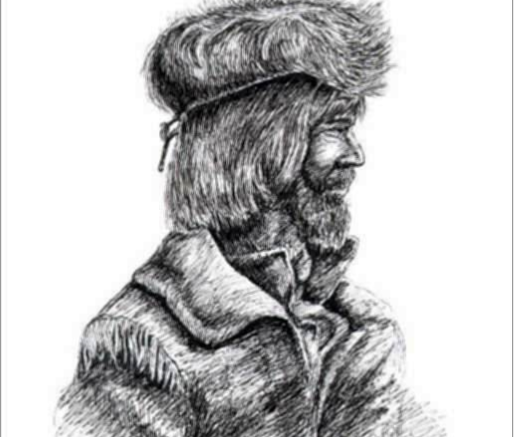Artists illustration of David Thompson, explorer and fur trader from descriptions. Photo courtesy of Brian Baxter, The Montanian
By Brian Baxter
In 1807, David Thompson and his party crossed the Rocky Mountains and began mapping and establishing trading posts in the Columbia River Basin. Thompson was commissioned by the British to find a water route to the Pacific Ocean, and to capitalize on the rich and abundant furbearer market in the Pacific northwest for economic prosperity. Hats made of beaver were tremendously popular in Europe at that time. Indigenous peoples knew the area, waterways, and the trails well, and their tribes had traditionally trapped, hunted, and fished these locations for many years.
The first white man many of the natives had met, Thompson built Kullyspel House near present day Hope, Idaho; Saleesh House near modern Thompson Falls, Mont.; and Fort Kootenai at the big bend of the Kootenai River and the confluence of what is now called the Fisher River near present Libby, Mont. At these posts, Kootenai, Cree, Piegan, Salish, and Flathead tribes, as well as local and traveling mountain men traded beaver, mink, otter, and ermine for European goods such as wool, knives, fire starters, and guns.
Approximately two-hundred and ten years later, and about twelve miles away as the crow flies from old Fort Kootenai, a group of modern day mountain men and women gathered for a fur handling clinic where we learned how to skin and put up furbearer pelts from experts. The main instructor began by skinning a beaver with surgical precision. He then set the hide on a beam, and used a fleshing knife to clean up the hide. Next, this experienced gentleman stretched the pelt on an oval wood form, also showing us a traditional hoop stretcher. He then gave additional instructions on how to put up, meaning to process the hide further for a quality fur.
Generally speaking, the main instructor, assistant instructors, and experienced trappers followed similar procedures with raccoon and muskrat hides. Another fellow showed us the intricacies of skinning a problem mink that he was hired to remove from a hatchery pond. We discussed a myriad of other topics including brain tanning, shearing hair, quality processing, and caring for the fur. The instructors really knew how to take their time, and use tricks they learned from experience.
This class was sponsored by Montana Trappers Association, and the instructor team stressed ethical trapping, working hard to avoid catching young species, and helping to educate youth. To find out more information on MTA, Youth Trapper Camps, and Montana Fur Harvesters in Kalispell, visit: www.montanatrap pers.org.
It was a great day, and we were treated to a hot lunch that even included an option of a beaver stew dish. All learned a lot, and the group consisted of folks eighteen to eighty years old. A father and son present that had just moved out from Hershey, Penn. and who had only been in Montana for six months remarked that they were just loving it.
When asked what he thought of the day, the main instructor said, “It was gratifying to see how many folks there are who are interested in this age old art.”

